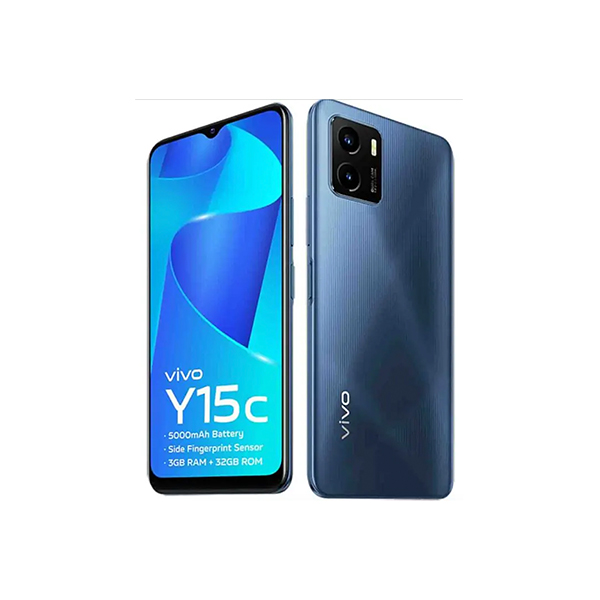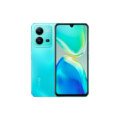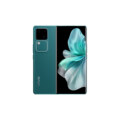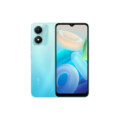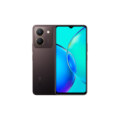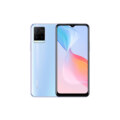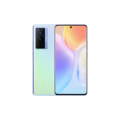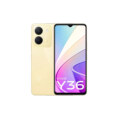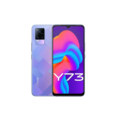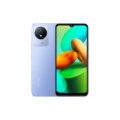Vivo Y15C



Specs
General
| Device Type | Vivo Phone |
| Announced | 02 July, 2022 |
| Released | 03 July, 2022 |
| Status | Available |
Design
| Dimensions | 160.80 x 73.79 x 8.42mm |
| Weight | 182 g |
| Protection | Glass front, plastic frame, plastic back |
| Colors | Midnight Galaxy, Ice Dawn |
Display
| Refresh Rate | 60 Hz |
| Display Type Display Technology => A number of display technologies and types used in mobile phones => TFT (Thin Film Transistor), IPS (In-Place Switching), OLED (Organic Light Emitting Diode), AMOLED (Active-Matrix Organic Light-Emitting Diode), Super AMOLED (an even advanced version of AMOLED), Resistive Touchscreen (Resistive touchscreens contain two layer of conductive material with a very small gap between them which acts as a resistance), Capacitive Touchsceen (Capacitive touchscreen technology consists of a layer of glass coated with a transparent conductor) | AMOLED |
| Size | 6.44 inches |
| Resolution | 1080 x 2400 pixels |
| Display Colors Display Colors is refers to the number of different shades of colors that the screen is capable of displaying => 64K colors, 256K colors and 16 million colors, Obviously 16M is highest available range of colors and better than others. | 16M Colors |
| Pixel Density Pixel Density (PPI) is refers to the concentration of pixels on a particular display, measured in pixels per inch (ppi). Pixel density is calculated by dividing the diagonal pixel resolution of a display by its diagonal size, higher pixel density better display quality. | ~ 409 ppi |
| Touch Screen | Capacitive Touchscreen, Multitouch |
| Display Protection Display Protection => Gorilla Glass is a special alkali-aluminosilicate glass shield with exceptional damage resistance that helps protect mobile displays from scratches, drops, and bumps of everyday use, It is always better to go for a smartphone with Gorilla Glass for that added protection and peace of mind. | Schott Xensation glass |
| Secondary Display | No |
Camera
| Front Camera | 16 MP, f/2.0, (wide) |
| Camera Setup | Triple |
| Main Camera Camera is able to capture photographs and usually videos, The most important characteristics of a camera are the resolution (measured in megapixels), lens focus type (fixed or automatic), higher megapixel cameras are known to capture higher quality photos, but not always a good measurement of the photos quality. |
50 MP, f/1.8, (wide) 2 MP, f/2.4, (macro) 2 MP, f/2.4, (depth) |
| Video | 1080p@30fps, gyro-EIS |
| Camera Features | Night, Portrait, Photo, Double Exposure, Live Photo, Panorama, Slow Motion, Time-Lapse, Pro, |
| Flash Flash Light => There is commonly two types of flash lights are used in camera mobile phones, LED Flash (LED flash offers lower power consumption with drive circuitry that takes up very little room, LEDs can be strobed faster than any other light source), Xenon Flash (xenon flash produces an extremely intense full-spectrum white light for a very short duration) | LED flash |
Hardware
| Operating System OS => Every computer system run on a base software called Operating System (OS). Operating System controls all basic operations of the computer (such as smartphone, PDAs, tablet computers and other handheld devices). The Operating System allows the user to install and run third party applications (apps), apps are used to add new functionality to the device. | Android 12 |
| Chipset Chipset is a group of integrated circuits designed to perform one or a more dedicated functions, often with real time computing constraints, Popular smartphones are equipped with more advanced embedded chipsets that can do many different tasks depending on their programming. | Qualcomm SM6225 Snapdragon 680 4G |
| CPU CPU (Central Processing Unit) mostly known as processors, CPU processes instructions in order to carry out certain functions that make your device operate properly. Processors are often described as the brain of computers, smartphones and tablets, Smartphones and tablets rely on processors to carry out their every task, Processors are an incredibly important factor in selecting any type of computing device, including your smartphone. | Octa-core (4x2.4 GHz Kryo 265 Gold & 4x1.9 GHz Kryo 265 Silver) |
| Architecture | 64 bit |
| Fabrication | 6 nm |
| GPU GPU (Graphics Processing Unit) is a single-chip processor designed to rapidly manipulate and alter memory to accelerate the creation of images in a frame buffer intended for output to a display, This includes things such as lighting effects, object transformations, and 3D motion. | Adreno 610 |
| RAM (Memory) RAM (Random Access Memory) is a type of computer memory that can be accessed randomly, any byte of memory can be accessed without touching the preceding bytes that allows information to be stored and accessed quickly from random locations. RAM is the most common type of memory found in computer systems, smartphones, tablets and other electronic devices. | 8 GB |
| Internal Storage Internal Storage is a data storage space (flash memory) mostly used in smartphones, tablets and other electronic devices where operating system, apps, music, photos, videos, files and other user data Is stored. | 128GB Built-in |
| Card Slot Memory Card Slot is a special slot for inserting a memory card. Memory cards allow you to expand the phone's built-in memory, A memory card (sometimes called a flash memory card or a storage card) is a small storage medium used to store data such as text, pictures, audio, and video, for use on small, portable or remote computing devices such as mobile phones, mp3 players, digital cameras. | |
| Sensors Sensors are electronic components that detects and responds to some type of input from the physical environment. The specific input could be light, heat, motion, moisture, pressure and location, The output is generally a signal that is converted to use in computing systems, a location sensor, such as a GPS receiver is able to detect current location of your electronic device. | Accelerometer, Compass, Fingerprint (under display), Gyro, Proximity |
Network
| SIM TYPE SIM (Subscriber Identity Module) is a small card that contains mobile network subscriber's account information. This allows the phone using the card to attach to a mobile network. The SIM card is most commonly associated with GSM and UMTS mobile networks. Moving a SIM card from one phone to another allows a subscriber to switch mobile phones without having to contact their mobile network carrier. SIM cards can also be used by a phone to store limited amounts of data, such as phone numbers and text messages. | Nano SIM |
| SIM Technology | Dual Sim, Dual Standby (Nano-SIM) |
| 2G Network | GSM 850 / 900 / 1800 / 1900 |
| 3G Network | HSDPA 850 / 900 / 1700(AWS) / 1900 / 2100 |
| 4G Network | LTE band 1(2100), 3(1800), 7(2600), 8(900), 20(800) |
Multimedia
| FM Radio | |
| Stereo Speakers | NO |
| Loudspeaker | YES |
| Audio Jack | 3.5mm Audio Jack |
| Audio Features | 24-bit/192kHz Hi-Res audio |
Connectivity
| Wi-fi Wi-Fi is a popular wireless networking technology using radio waves to provide high-speed network connections that allows devices to communicate without cords or cables, Wi-Fi is increasingly becoming the preferred mode of internet connectivity all over the world. | Wi-Fi 802.11 a/b/g/n/ac, dual-band, Wi-Fi Direct |
| Bluetooth Bluetooth is a wireless communications technology for exchanging data between mobile phones, headsets, computers and other network devices over short distances without wires, Bluetooth technology was primarily designed to support simple wireless networking of personal consumer devices. | v5.1 with A2DP, LE |
| GPS GPS The Global Positioning System is a satellite-based radio navigation system, GPS permits users to determine their position, velocity and the time 24 hours a day, in all weather, anywhere in the world, In order to locate your position, your device or GPS receiver must have a clear view of the sky. | A-GPS support, & GLONASS, BDS, GALILEO, QZSS |
| USB | USB Type-C, USB On-The-Go |
| EDGE EDGE (Enhanced Data GSM Environment) is a wireless network technology generally considered the next step in the 2G network offers data transfer rates up to four times faster than ordinary GSM networks, Generally, EDGE is used for the purpose of wireless data transfer, such as sharing pictures and videos or browsing the Internet via a mobile phone connection. | |
| GPRS GPRS (General Packet Radio Service) is a packet oriented mobile data service on the 2G and 3G cellular communication system's global system for mobile communications (GSM), Generally, GPRS is used for the purpose of wireless data transfer, such as sharing pictures and videos or browsing the Internet via a mobile phone connection. | |
| Speed | 3G (HSPA 42.2/5.76 Mbps), 4G LTE-A |
| Wi-fi Hotspot | |
| NFC NFC (Near field communication) is a set of standards for smartphones and similar devices to establish peer-to-peer radio communications with each other by touching them together or bringing them into proximity, usually no more than a few inches. |
Features
| Messaging | SMS(threaded view), MMS, Email, Push Mail, IM |
| Web Browser Web Browser => a web browser is a software application used to locate, retrieve and display content on the World Wide Web, including Web pages, images, video and other files, The primary function of a web browser is to render HTML, the code used to design or markup webpages. | HTML5 |
| Games | Built-in + Downloadable |
| Torch |
Battery
| Battery Type Battery Type => Cell phones run on various kinds of batteries depending on the manufacturer, phone size or shape and features. There are basically four types of cell phone batteries => Lithium Polymer, Lithium Ion, Nickel Metal Hydride and Nickel Cadmium. | Li-Ion (Lithium Ion) |
| Capacity Battery Capacity is a measure (typically in Amp-hr) of the charge stored by the battery, and is determined by the mass of active material contained in the battery. The battery capacity represents the maximum amount of energy that can be extracted from the battery under certain conditions. | 5000 mAh |
| Placement | Non-removable |
| Wireless Charging Wireless Charging (Inductive Charging) uses an electromagnetic field to transfer energy between two objects. This is usually done with a charging station. Energy is sent through an inductive coupling to an electrical device, which can then use that energy to charge batteries or run the device. | No |
| Extra |
44W wired 50% in 27 min (advertised) |
Vivo Y15C Detailed Review
Introduction: The Vivo Y15C was launched in March 2022 as an affordable entry-level smartphone offering from Vivo. It aims to deliver essential features at a budget-friendly price point. This review provides an in-depth look at the Vivo Y15C, covering its design, display, performance, camera system, battery life, software, and more, along with a summary of its pros and cons.
Specifications at a Glance:
- Display: 6.51-inch IPS LCD (1600 x 720 pixels, 270 ppi)
- Processor: MediaTek Helio P35 (MT6765) with an octa-core CPU
- RAM: 3 GB
- Storage Options: 64 GB (expandable via microSD card)
- Rear Cameras: Dual 13 MP (wide) + 2 MP (depth) with LED flash
- Front Camera: 8 MP (wide)
- Battery: 5000 mAh with 10W charging
- Operating System: Funtouch OS 12 based on Android 12
- Audio: Stereo speakers, Micro-USB port (no headphone jack)
- Dimensions: 164 x 76.1 x 8.28 mm
- Weight: 179 grams
Design and Build Quality:
- Aesthetics:
- Familiar Design: The Vivo Y15C features a classic design with a glossy back panel that houses the dual-camera setup.
- Color Options: Available in multiple colors including Mystic Blue and Burgundy Red.
- Durability:
- Build Quality: The device uses a plastic back and frame, which helps in keeping the cost low but might not feel as premium.
- Ergonomics:
- Comfortable Size: The 6.51-inch display size provides a good balance between screen space and portability, making it comfortable for daily use.
- Fingerprint Sensor: Positioned on the side, integrated with the power button for easy access.
Overall, the Vivo Y15C offers a straightforward design and build quality that suits its budget-friendly price range, providing a solid choice for users seeking basic functionality.
Display:
- Specifications:
- Size: 6.51-inch IPS LCD Display
- Resolution: 1600 x 720 pixels (270 ppi)
- Panel Type: IPS LCD
- Brightness: Up to 550 nits (typical)
- Performance:
- Display Quality: The IPS LCD provides decent color reproduction and viewing angles, although the HD+ resolution may appear less sharp compared to Full HD displays.
- Brightness: Adequate for most indoor and moderate outdoor conditions.
- Color Accuracy: Colors are generally accurate, though not as vibrant as higher-end models.
In summary, the Vivo Y15C’s display delivers satisfactory performance for everyday tasks, though it may fall short for users seeking higher resolutions and richer colors.
Performance:
- Hardware:
- Processor: MediaTek Helio P35 (MT6765) with an octa-core CPU
- RAM: 3 GB
- Performance Evaluation:
- General Performance: The Helio P35 provides adequate performance for basic tasks such as browsing, social media, and light gaming. However, it may struggle with more demanding applications.
- Multitasking: With 3 GB of RAM, the device handles basic multitasking reasonably well, though users may experience some slowdown with multiple apps open.
- Benchmark Scores:
- Antutu Score: Approximately 85,000 (varies with software and usage conditions)
Overall, the Vivo Y15C offers decent performance for its price range, making it suitable for users with basic needs and limited multitasking.
Camera:
- Rear Cameras:
- Primary Lens: 13 MP wide-angle lens with f/2.2 aperture
- Depth Lens: 2 MP depth sensor for portrait mode
- Features: LED flash, HDR, panorama
- Front Camera:
- Resolution: 8 MP with f/1.8 aperture
- Features: HDR, video recording
- Camera Performance:
- Daylight Photography: The 13 MP primary camera captures decent photos in good lighting conditions with adequate detail and color accuracy.
- Low-Light Photography: The performance in low-light conditions is average, with potential noise and reduced detail.
- Portrait Mode: The depth sensor helps achieve a basic bokeh effect, though edge detection may not be perfect.
In conclusion, the Vivo Y15C’s camera system performs adequately for casual photography and social media use, though it lacks advanced features and may struggle in low-light scenarios.
Battery Life:
- Specifications:
- Battery Capacity: 5000 mAh
- Charging Options: 10W charging
- Performance:
- Battery Life: The 5000 mAh battery provides excellent endurance, comfortably lasting through a full day of moderate to heavy use. With lighter usage, it can extend into the second day.
- Charging Speed: Charging is relatively slow with 10W support, taking around 2.5 hours to fully charge from 0% to 100%.
In summary, the Vivo Y15C offers strong battery life, making it a reliable choice for users who prioritize longevity over fast charging.
Software:
- Operating System:
- Original OS: Funtouch OS 12 based on Android 12
- Upgradability: As of now, the device is upgradable to the latest software updates within the Android 12 ecosystem.
- User Experience:
- Interface: Funtouch OS 12 provides a user-friendly interface with various customization options and features.
- App Compatibility: The device supports a wide range of apps available on the Google Play Store, though newer and more demanding apps might experience performance issues.
- Additional Features: Includes basic Vivo features like Multi-Turbo for improved performance and a game mode for enhanced gaming experience.
In summary, the Vivo Y15C’s software offers a functional experience with essential features, making it suitable for users who need a straightforward Android experience.
Pros & Cons:
Pros:
- Strong Battery Life: The 5000 mAh battery provides impressive longevity, lasting through a full day of usage.
- Affordable Price: Offers good value for money with its budget-friendly price point.
- Decent Build Quality: The design and build are adequate for the price, offering a comfortable user experience.
Cons:
- Average Display Quality: The HD+ resolution may not satisfy users seeking sharper and more vibrant visuals.
- Limited Performance: The Helio P35 processor and 3 GB of RAM may struggle with more demanding tasks and multitasking.
- Slow Charging: The 10W charging speed is slower compared to more modern devices.
- Basic Camera System: The camera performance is adequate for casual use but lacks advanced features and struggles in low-light conditions.
Conclusion: The Vivo Y15C is a solid entry-level smartphone that delivers essential features at a budget-friendly price. With strong battery life, decent build quality, and a user-friendly software experience, it is a reliable choice for users with basic needs. However, its display resolution, performance limitations, and slow charging may be drawbacks for those seeking more advanced features or a higher-end experience.
Review
Disclaimer Note
All prices in Pakistan is updated daily from the price list provided by local shops and dealers but we can not guarantee that the information / price on this page is 100% correct (Human error is possible), always visit your local shop for exact cell phone cost & rate.
